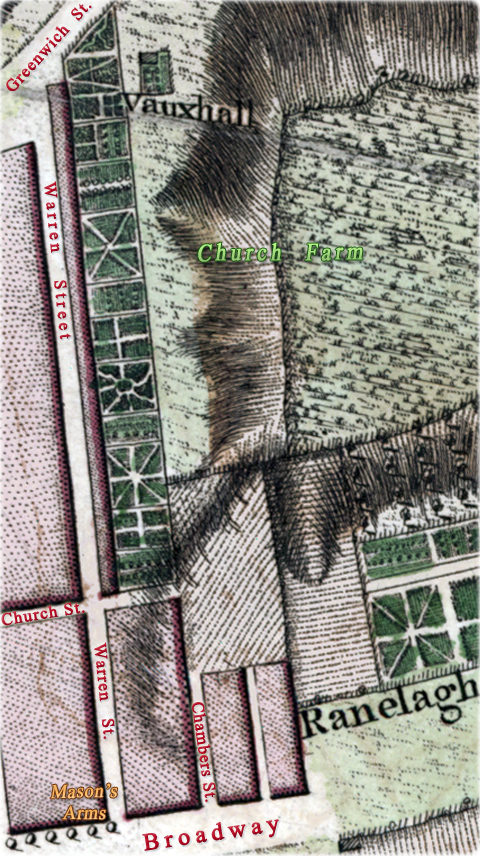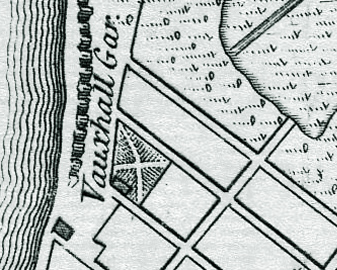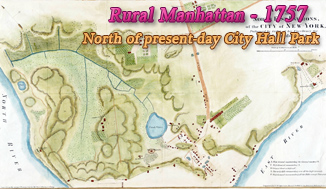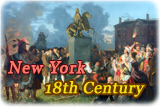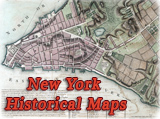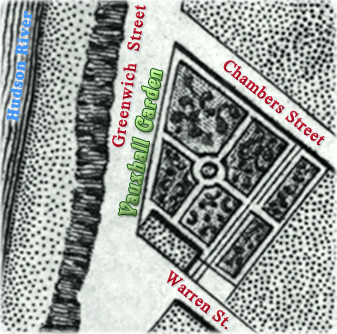The first Vauxhall Garden in New York was a resort located on
the Hudson River front, between Greenwich, Warren and Chambers
streets. This recreational space was the site of the
old Bowling Green, leased from
Trinity Church, as part of the
old Church Farm. It was one of the first pleasure gardens in New York, initially
established by John Marshal, in 1759, as Mount Pleasant. In 1762, John Elkin
succeeded him and renamed it Spring Gardens. In 1764,
Samuel Fraunces succeeded Elkin and renamed it
again as Spring Gardens Vauxhall, later Vaux-Hall Garden and later, just
Vauxhall. Other proprietors took over the place and it seems it was closed by
the late 1780s. This Vauxhall is indicated in some maps of the time, like the
Ratzer's Plan (1767) and in
two plans of the City, published in 1776 (fragments on the right).
The New York Vauxhall was named after the Spring Gardens at Vauxhall in London, established in the 17th century, later known as Vauxhall Gardens. According to N.Y. Post-Boy (February 27, 1758), an early Vaux-Hall existed in New York. The House of Mr. Keen, was commonly call by that name.
In the early 18th century, the site near the Hudson River, in Manhattan, was part of the Church Farm, the former Queen's Farm granted by Queen Anne in 1705 to Trinity Church. It was the place of the old Bowling Green Garden. That was before the Bowling Green, near the Battery, was leased to make a bowling green, in 1733. In 1735 the house of the Bowling Green Garden was leased and occupied by John Miller, who offered garden seeds of several sorts for sale. He left the place in 1739.
According to the New York Post-Boy (Nov. 12, 1759), on February 13, 1752, Adam van Denberg leased the old Bowling Green for 21 years. In 1759, he passed the lease to John Marshal, then the place was called Mount Pleasant. On October 27, 1762, the house and gardens were again offered for sale. John Elkin succeeded Marshall and renamed the place Spring Gardens.
In 1764, Fraunces succeeded Elkin and, on December 6, he announced in the New York Post-Boy: Samuel Francis “begs leave to observe that he has completely fitted up his House and long Room at Spring Gardens Vauxhall." The property was leased from Trinity Church for a long period ahead (there were 61 years to run in May 1773). It contained twenty-seven and a half lots of ground.
On May 16, 1765, Fraunces advertised the "New Vaux Hall" (N.Y. Post-Boy) and, the same day, the New-York Gazette of May 16, 1765, reported: the "New Vauxhall" opened for the summer season. According to W.H. Bayles (Old Taverns of New York, 1915), a ball, which seems to have been of some importance, was given in Vauxhall about the first of June, 1765.
On June 6, 1765, John Jones, who had acquired Mason's Arms from Fraunces in 1762, opened a new pleasure garden called Ranelagh on present-day Broadway and Thomas Street.
Fraunces moved to Philadelphia in the late 1765 and Vaux-Hall became the residence of Major Thomas James (c.1720-1782), the commander of the British Artillery at Fort George in New York. On November 1st, during the Stamp Act protests, the place was ransacked and all his possessions burned, including his library. Major James had announced before that he would "cram the Stamps down their throats". Those were pre-revolutionary times.
In 1768, after returning to New York, Fraunces reopened his summer resort as the Vaux-Hall Garden (also referred as Vauxhall Garden or simply Vauxhall). On June 16, 1768, Fraunces announced in the New-York Journal (title Vaux-Hall Garden) that, "since his Absence from this City, the House and Gardens, have been occupied by Major James, and are now in good order". On July 21, Fraunces announced in the N.Y. Journal wax figure showing at Vauxhall.
In addition to a beautiful landscape, there were a wax museum, fireworks display, evening amusements and several summer houses. Adjoining the main house, there was also a Long Room, 56 feet long and 26 feet wide, under which was a large, commodious kitchen. There were stables, a coach house, two large gardens planted with fruit trees, flowers and flowering shrubs, one of which stocked with vegetables of all kinds. It served tea, coffee, wine, liquors and other beverages, hot rolls, and “ice cream” dessert.
On November 16, 1768, Sam Fraunces applied to Trinity vestry for an extension of his lease of Vauxhall Garden and, on March 25, 1769, he leased part of the Church Farm bounded by Greenwich Road, Chambers, Chanel, and Warren streets. In June he advertised Vauxhall "newly fitted up" he adds that they "would have been opened earlier in the Spring, but on account of the Theatre." (N. Y. Chron., June 5-8, 1769).
In August 3, 1769, Fraunces announced in the New-York Journal that the Vaux-Hall Gardens "Have been newly fitted up in a very genteel, pleasing Manner... and will be illuminated every Evening in the Week... A Concert of Music Vocal and Instrumental will shortly be performed twice every Week...―Contiguous to the Garden there is a very good Long Room, convenient for a Ball, or Turtle Entertainment; also Dinners or Suppers, dressed in the most elegant Manner..." Note after signature "Samuel Francis": "The Garden would have been opened earlier in the Spring, but on Account of the Theater."
On January 24, 1771, Fraunces offers for sale his house, gardens and stables in Vauxhall in the N.Y. Journal. The house had "4 good rooms on a floor, with a large entrance and other conveniences, an excellent cellar, a very good Kitchen, and a large room 26 by 56 feet adjoining the house, with an arched ceiling, a convenient musick gallery, two fire places and two entrances". On January 28, Vauxhall was offered for sale again in the New York Gazette and Weekly Mercury: “To be sold at private Sale, the commodious house and large gardens, in the out ward of this city, known by the name of VAUXHALL; the situation extremely pleasant, having a very extensive view both up and down the North River. . . there are 36 lots and a half of ground laid out to great advantage in a pleasure, and kitchen garden, well stock’d with fruit and other trees, vegetables, &c. and several summer houses which occasionally may be removed; the whole in extreme good order and repair, well fenced in, very fit for a large family, or to entertain the gentry, &c. as a public garden, &c. The premises are on lease from Trinity Church, sixty one years of which are yet to come.”
By May 1771, Warren Street was under reconstruction and Fraunces petitioned Trinity vestry asking for some compensation for the damage by lowering the street in front of his house at Vauxhall.
On May 25, 1772, Samuel Francis, in advertising his Queen’s Head Tavern, also announces “that his gardens at Vaux-Hall, ... are now open for the Summer season...” (N.Y. Mercury).
On July 6, 1772, Fraunces announced, in the N.Y. Mercury, his collection of wax figures in Vauxhall: "a number of Wax Figures as large as life, drest in the newest and most elegant manner, representing their present Majesties, King George and Queen Charlotte, sitting on the throne, with their usual attendants, several of the nobility, &c, properly disposed in a large appartment genteely fitted for the purpose, and proper persons to shew the same, from eight in the morning till ten in the evening". By July 27 he added "Banquet in Macbeth, with the Appearance of Banquo's Ghost, and a large Gallery filled with Spectators" and "Harlequin and Columbine".
Fraunces offered Vauxhall for sale again on May 13, 1773 (Rivington's Gazetteer) and again on June 14, 1773, in the N.Y. Mercury:
"To be Sold at public Vendue, on the Premises, The first day of September next, or at private Sale any Time before. The large commodious and well fitted House and Gardens, in the Out-Ward of this City, wherein Col. James formerly lived, and is known by the name of Vauxhall. The situation is extream healthly and pleasant, commanding an extensive prospect up and down the North-River: The House has four large rooms on a floor, twelve fire-places, most excellent cellars, and adjoining the house is built a compleat room, 56 feet long and 26 wide, ... under which is a large convenient kitchen and other offices, with a coach-house and stables, a well of the very finest water, pump, cistern, pigeon-house, &c.
The gardens are large, and laid out in a neat, genteel manner. The upper garden is planted with the very best fruit trees of different sorts; flowers and flowering shrubs all in great perfection: The lower garden is plentifully stocked with vegetables of every kind, sundry fruit trees, and every other necessary for the family use, ...
The premises contain twenty seven lots and an half of ground, held under lease from Trinity Church, of which there are now 61 years to come. Further particulars may be known, by applying to Mr. Samuel Francis, at the gardens, or at his house the Queen's Head tavern, near the Exchange, in Broad-Street, who will accept of half the purchase- money paid down, and security for the remainder.
Until the premises are sold, there will be the usual genteel accommodations. Tea, Coffee, Hot Rolls, &c. &c. and the elegant Wax-Work Figures to be seen at all hours in the day."
But Vauxhall was not sold and, on September 23, 1773, he advertised the auction of Vauxhall for September 29, in the Rivington's Gazetteer at the Merchant's Coffee-House, stating that at which time a sale would be "positively made". On October 14, he announced he removed his collection of wax figures to the Queen's Head Tavern (Rivington's Gazetteer).
On October 25, 1773, Erasmus Williams announced in the N.Y. Mercury that he had purchased "the large, elegant, pleasant and healthy situated House and Gardens of Mr. Samuel Francis, called Vaux-Hall, and intends fitting it up for a Lodging-House". By December 27, Williams changed the name of the place to Mount Pleasant, as it was known before in 1759.
On June 6, 1774, Erasmus Williams announced in the N.Y. Mercury that he had acquired the large commodious house and gardens, coach house, stables etc., "heretofore known by Vaux-Hall", but changed to Mount Pleasant. Besides the beautiful view and the healthfulness of the place, it was "near the College, and Hospital now erecting, and so contiguous to the city that a moderate walker may, in 15 or 20 minutes, be in any part thereof". Williams offered board and lodging to "single gentlemen, or gentlemen with their families", especially travelers.
The British invaded the City of New York in September, 1776. Many civilians had already left the City, including Samuel Fraunces, who was in New Jersey at the time. By August 1777, British officials turned Vauxhall into a military hospital. The pleasure garden was then still in operation according to English diarist Nicholas Cresswell (1750-1804), who went to see Vauxhall Gardens on September 4, 1777 and wrote: "This is the last night that they kept open for the season. There have been some lamps broken by the Mob, and other riotous proceedings" (Journal of Nicholas Cresswell, 1924). In August 1777, Johnann Conrad Döhla (1750-1820), a Hessian soldier mentioned in his diary (Hessian Diary of the American Revolution, 1993): Sergeant Vollrath died in the hospital called Vauxhall in New York and, in July 1783, corporal Wolfrum died in the English hospital at Vauxhall. In November, 1783, the British left New York.
According to Thomas Smith (City of New York...1789, 1889), in 1789, Greenwich Street was one of the streets upon which the greatest improvements were being made. In July 1788, the Common Council ordered the paving of it from Cortlandt to Barclay Street. Subsequently this work was ordered to be extended to Warren Street, and by September, 1789, it had progressed so far that a committee was appointed to investigate the error in it.
In June 1789, the corporation of Trinity Church announced the sale at auction of the lots of Vauxhall. On May 29, 1792, Vauxhall was again offered for sale "The lot is 120 feet front on Warren street, has 15 fire places ... The stable is 35 feet in front, on Chambers street, and 21 feet deep". This and a building in the rear were built two years ago (N.Y. Journal & Pat. Reg.). On February 8, 1794, it was offered again for sale.
By 1802, the site of the old Vauxhall on the North River was turned over to the proprietors of the Cupola Iron Furnace, according to the New York Evening Post (August 17, 1802).
In 1798, another Vauxhall Garden was established by Joseph Delacroix located near present Grand and Mulberry streets. In 1803, Delacroix moved its Vauxhall Garden to Broome Street, between Broadway and the Bowery.

